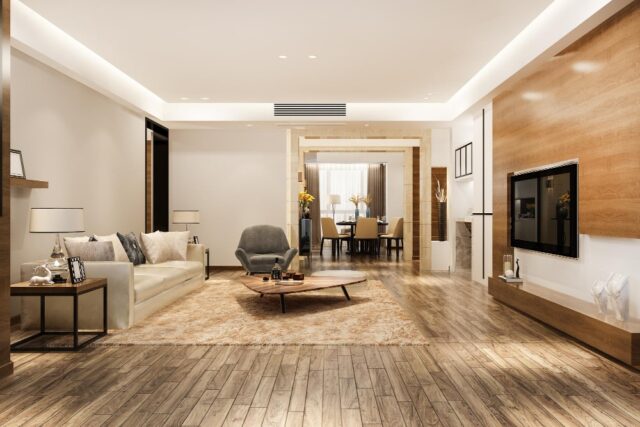There are lots of possibilities on the market if it’s time to change the wood flooring in your house. Hardwood flooring is a fantastic option if you’re searching for something classic and natural. However, it can be difficult to choose the best flooring option for your house when there are so many options available. The various types of wood flooring in Melbourne will be covered in this blog post. Let’s get started.
Different Types of Wooden Flooring
1. Solid Hardwood Floors
The most costly choice is solid hardwood, which is constructed from a single piece of wood. It’s a wise decision if you live in a busy neighbourhood. Solid hardwood is sandable and refinishable multiple times, and its organic appearance and feel can raise the value of your house.
2. Engineered Hardwood Floors
If you want a lovely look but live in a region where solid wood flooring is not advised, like a humid one, engineered wood flooring is an excellent alternative. Many pieces of wood are bonded together to create engineered hardwood flooring. Although it costs less than solid flooring, it cannot be polished or sanded as frequently.
3. Laminate Floors
Laminate is produced from synthetic floor materials and is the cheapest option. It is not recommended for an area with heavy foot traffic because it is quickly soiled or scratched. On the other hand, if you’re on a tight budget or like a more casual look, this is a great option.
Factors to Consider When Choosing Floors
1. Foot Traffic in Your Home
You’ll need a timber floor in Melbourne option that will resist wear and tear if your property is frequently visited by people. If you want a hardwood that is both resilient to scratches and long-lasting, options like oak or bamboo are excellent possibilities. Laminate flooring is not advised for high-traffic areas; solid hardwood is a better choice.
2. Climate of Your Area
Solid hardwood can swell and buckle, but engineered hardwood is a better option if you live in a humid climate. Solid hardwood species, such as maple or hickory, are a great choice if you live in a cold area because they are more resilient to moisture and warping than other hardwood varieties.
3. Style of Your Home
When selecting hardwood flooring, you should also consider the style of your house. Bamboo or oak floors might be a wise choice for a traditional or rustic home. However, cherry or maple can be a better choice if your house is more contemporary. They have a beautiful finish that will add a little elegance to your house.
4. Maintenance
If you want your wood floors to last for a long time, maintenance is essential. Your floors should be swept and mopped at least once a week, and every few years, you might wish to apply a coat of polyurethane. Additionally, use a doormat and keep your wood flooring in Melbourne away from damp spots to prevent water damage. Put felt floor pads or floor protectors on the bottom of any couches or dining room table legs if you have furniture on your floors.
While certain hardwood flooring kinds require less maintenance than others, all of them do require some upkeep. Regular sweeping and sealer application may be required for solid hardwood floors every few years. Although it doesn’t need to be sealed, engineered hardwood still needs to be cleaned frequently. The simplest type of flooring to maintain is laminate, which only requires routine sweeping and moist cloth mopping.
5. Grain Pattern
There are three different ways to chop logs: quarter-sawn, rift-sawn, and plain-sawn. Every technique may result in a distinct grain pattern.
Plan-sawn wood has cathedral-like or classic wavy patterns in its grain. The grain of rift-sawn boards is long, straight, and uniform, with no cathedrals. Similar to rift boards, but with more erratic figures are quarter-sawn boards. Hardwood flooring is usually offered in a set of three cuts.
6. Plank Width
Although most hardwood flooring is laid in two- to three-inch strips, more homeowners are opting for broader planks. Wider plank floors are less likely to have seams than floors with thinner strips. Remember that the more the wood expands and contracts as a result of the uneven distribution of movement, the more obvious the seams may become.
7. Pre-finished or Unfinished Flooring
In the manufacturer, pre-finished flooring goes through a preservation procedure. The majority of manufacturers will sand, stain, and apply a polyurethane coating. The boards might also be oven-baked, which produces a firm finish. The bevelled edges of pre-finished boards are a disadvantage since they result in uneven flooring after installation. Conversely, a floor made of site-finished wood is smooth and level since there are no visible seams between the planks.
Pre-finished flooring also results in reduced chemical exposure and mess. Dust is produced during sanding. Chemical application at the job site is then required.
Furthermore, pre-finished hardwood floors lack the natural appearance of untreated hardwood. Pre-finished timbers have less obvious grain patterns. It is typically colder than unfinished floors.
Additionally, applying distinctive dyes and customizing an unfinished hardwood floor is simpler. You can connect with a professional to apply the colour of your choice. But if you want to get pre-finished timber supplies in Melbourne, you have to settle for what the store has to offer.
Purchasing unfinished hardwood floors is less expensive than purchasing pre-finished flooring, but the latter becomes expensive when you factor in the fees associated with sanding, staining, and finishing. Pre-finished flooring is, therefore, less expensive overall than untreated hardwood flooring.
Conclusion
If you’re considering remodelling your old house, Greenhill Timbers offers a wide range of beautiful hardwood flooring solutions. Our professionals will help you in selecting the ideal hardwood flooring for your house and way of life. Call us right now!











